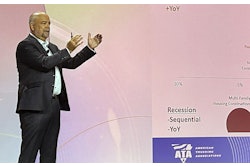The Federal Motor Carrier Safety Administration released a study concluding that less than a quarter of over-the-road truck drivers drive more than 10 hours in a shift.
The current rules allow for 11 hours of driving before 10 hours of consecutive rest is required. The rules in effect before Jan. 4, 2004, allowed only 10 hours of driving.
FMCSA’s study also found that drivers rarely worked more than 13 hours in an on-duty cycle, and those who used split sleeper berth provisions typically had one period of six hours or greater.
The agency collected data from the logbooks of 542 drivers at 269 carriers during compliance reviews in January and February. FMCSA excluded drivers that were found to have falsified their records.
The review included 6,850 driving, 7,262 on-duty and 2,928 sleeper berth periods. Key findings include:
More than 70 percent of the drivers in the review of data used the 34-hour restart provision of the rule. For these drivers, a total of 1,411 recovery periods were recorded – the bulk of those recovery periods exceeded 44 hours, while only 15 percent recorded recovery times of less than 36 hours.
When FMCSA revamped the 70-year-old hours of service rule, it extended the number of hours a driver could drive in a single duty cycle from 10 to 11, retained sleeper berth exemptions and added the 34-hour restart provision – all of which have been criticized by safety advocates.
Those advocates have won key court battles to force the agency to rewrite the rule again – this time with driver health in mind. The agency says it has focused on revamping the rule since Congress gave it a reprieve last year. That reprieve ends in September when the agency must meet a court order to consider driver health. What changes to the rule – if any – it will announce have not been made public.
But the agency recently has released a flurry of surveys, scientific sleep studies and other comments through its online docket system. The field report on driver logbook habits was released Aug. 16.
For a copy of the FMCSA HOS Field Survey, click here.


![Volvo Vnl Sleeper Review[20]](https://img.ccjdigital.com/mindful/rr/workspaces/default/uploads/2025/11/volvo-vnl-sleeper-review20.lrVppY9UDR.jpg?auto=format%2Ccompress&fit=crop&h=167&q=70&w=250)



